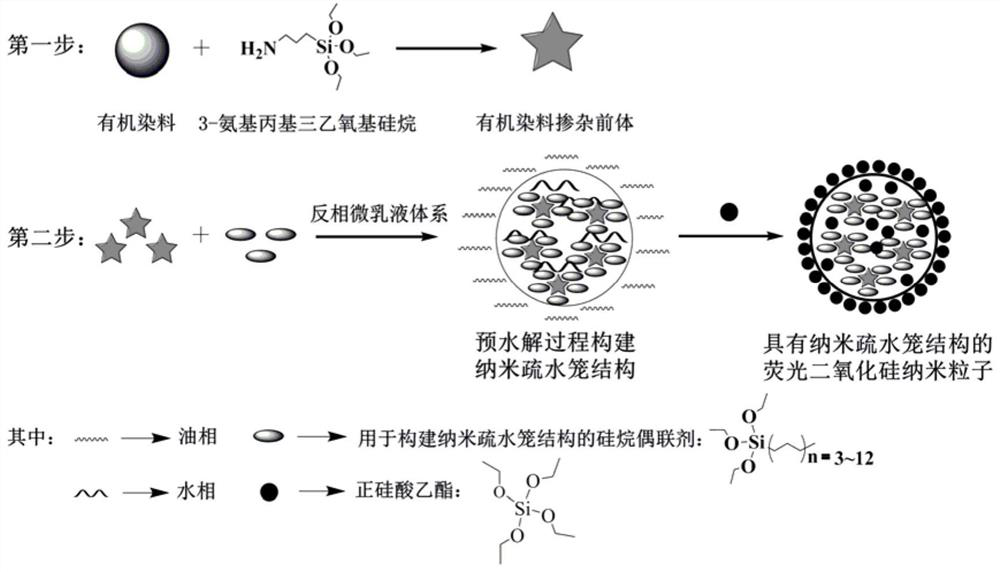Fluorescent silica nanoparticles with nano-hydrophobic cage structure, preparation method and application thereof
A silica and nanoparticle technology, applied in the field of biomedicine, can solve the problems of limiting biomedical applications, reducing the fluorescence intensity of fluorescent silica nanoparticles, photostability and photodynamic treatment effect, etc., to achieve optimal photostability , Enhance the effect of photodynamic therapy, the effect of high phototoxicity
- Summary
- Abstract
- Description
- Claims
- Application Information
AI Technical Summary
Problems solved by technology
Method used
Image
Examples
preparation example Construction
[0039] The preparation method of fluorescent silica nanoparticles with nano-hydrophobic cage structure, see the preparation process figure 1 , including the following steps:
[0040] (1) Preparation of organic dye doping precursor: Dissolve organic dye fluorescein, rhodamine derivative or cyanine dye containing carboxyl group and 3-aminopropyltriethoxysilane in a molar ratio of 1:3 In anhydrous dimethylformamide, under nitrogen protection, 60 ℃, magnetic stirring reaction for 2 ~ 4h, precipitating and washing with 10mL ether, and drying to obtain organic dye doping precursor;
[0041] (2) Pre-hydrolysis to construct a nano-hydrophobic cage structure: 3.5g of Triton X-100, 4.4mL of n-octanol and 20mL of cyclohexane were sequentially mixed in a 100mL round-bottomed flask, and the rotating speed was adjusted to 350rpm and stirred at room temperature for 5-10min; The organic dye doping precursor prepared in step (1) is dissolved in ultrapure water, added dropwise to the above inv...
Embodiment 1
[0046] Organic dye doping precursor: The synthetic route of heptamethyl tetraaminocyanine dye precursor is:
[0047]
[0048] Dissolve 0.15 mmol of heptamethanine dye and 0.45 mmol of 3-aminopropyltriethoxysilane in 10 mL of anhydrous dimethylformamide, react under nitrogen protection, 60 ℃, magnetic stirring for 4 h, and precipitate with 10 mL of ether and washing and drying to obtain an organic dye-doped precursor.
Embodiment 2
[0050] Preparation of fluorescent silica nanoparticles FSNPs-1 with nano-hydrophobic cage structure.
[0051] (1) Mix 3.5g Triton X-100, 4.4mL n-octanol and 20mL cyclohexane in sequence in a 100mL round-bottomed flask, adjust the rotational speed to 350rpm, and stir the microemulsion system for 10min at room temperature;
[0052] (2) The organic dye-doped precursor prepared in Example 1 was dissolved in 1 mL of ultrapure water, and added dropwise to the above-mentioned inverse microemulsion system. Then, 200 μL of n-propyltriethoxysilane, a silane coupling agent for constructing a nano-hydrophobic cage structure, was added dropwise to the above system. After stirring at room temperature for 30 min, 100 μL of ammonia water was slowly added dropwise to the above system to start the hydrolysis polymerization reaction for pre-hydrolysis. , to construct a nano-hydrophobic cage structure;
[0053] (3) After 12 hours of reaction at room temperature, 200 μL of ethyl orthosilicate was...
PUM
 Login to View More
Login to View More Abstract
Description
Claims
Application Information
 Login to View More
Login to View More - R&D
- Intellectual Property
- Life Sciences
- Materials
- Tech Scout
- Unparalleled Data Quality
- Higher Quality Content
- 60% Fewer Hallucinations
Browse by: Latest US Patents, China's latest patents, Technical Efficacy Thesaurus, Application Domain, Technology Topic, Popular Technical Reports.
© 2025 PatSnap. All rights reserved.Legal|Privacy policy|Modern Slavery Act Transparency Statement|Sitemap|About US| Contact US: help@patsnap.com



